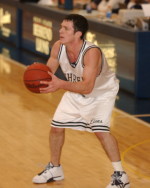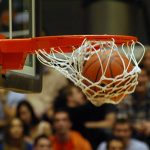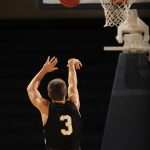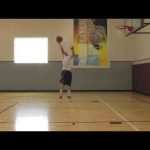If you can shoot, you will likely always find a home. The NBA (not to mention college teams & high schools) has always seemed to find a home for someone who shoot the lights out. Many of these players throughout the history of hoops have been average or below average athletes, but the fact that their basketball shooting ability struck fear into the hearts of their opponents always gave them a chance to get on the court. Because everyone in the gym knows that at any time…they could hit 3, 4, 5 or more shots in a row. Oh yeah, and you need to score points to win a basketball game.
This is good news. Actually, it is great news, because, ANYONE can become a great shooter. Shooting is a skill that can be learned and perfected. If you are willing to learn the basic basketball shooting form, be disciplined enough to practice them, and spend the time to prefect your shot, then you can become a deadly shooter.
Even if you are already a good shooter, you should pay attention. You will likely find some things in this video that will make you even better.
Basketball Shooting Form
1. We need to build a repeatable & precise shot
2. We need to learn how to generate force
3. We need to always be relaxed when shooting
4. We need to make the hoop big (get the proper arc on our shot)
Hand and Finger Position
In order to do these things, we break down the mechanics of a shot into a few videos. The first is hand and finger position. This is vital because your hands and fingers are the last things that touch the ball prior to release. They hold the final determination if your shot will go in. If you are holding the ball wrong, this is going to cause you problems down the line.
Place one hand behind the ball and the other on the side…
- Use fingers & finger pads – not the palm – to hold the ball. The palm causes you to lose back spin on the ball; it forces you to lose accuracy and control over the flight of the ball. The fingers & finger pads will give you the control you need.
- The fingers should be spread, but relaxed. Do not try to spread them as wide as you can, and the thumb should be out to the side…if you spread too hard, you lose control of the shot and lose touch, if hands aren’t spread you lose accuracy
- The “guide” hand is on the side, it should also be relaxed. The two thumbs should create a “V” shape if you look down at them
- The ball should rest ALMOST flat to the palm, but not quite. You should be able to slide one finger between your hand and the ball. If you can’t slide a finger in, it’s too close to the ball, if you can slide more than a finger in…it’s resting to high up on the fingers and thumbs.
- The index & middle finger are the last two to come off the ball
- Just like everything else in shooting – you need to stay relaxed…keep the arms, hands and fingers all relatively relaxed.
The Shot Pocket and Set Position
The shot pocket is the area in which the ball is held at approximately (show a shooter from the front, side, back) chest height that where it is ideal to move into the set point and the shot.
The Shot Pocket
This is very similar to the triple threat stance and you transition right from triple threat into a shot when it applies. Here is how the stance should look:
- Knees bent, slightly forward at the waist, back straight, eyes straight ahead, feet at shoulder width (or slightly narrower)
- Be sure you have good balance, your hands in correct shooting position on the ball (at chest height), slightly to the right side of your body.
- Right foot slightly in front of the left (for righties, opposite for lefties)
- The entire right (or left if you are left handed) side of your body should be aligned
The Set Position
The set position is the point at which the ball is actually ready to be shot. Here is a description of the set position:
- Hands in the position we learned earlier
- Ball slightly to the right of your face (to the left of your face for lefties)
- Ball held just over eye level (if you haven’t yet developed enough strength to start with ball just over eye level, you may hold a little lower…this just results in a slightly slower release)
- The elbow is pointing straight ahead, not pointing out to the side forming an L
- Wrist cocked back so it is almost flat – like a waiter carries a tray of drinks
- A “trick” is to be able to hold the basketball under the L and the wrist – that is how you know the correct elbow and wrist placement
AGAIN – the entire right (or left if you are left handed) side of your body should be aligned (ankle, knee, hip, shoulder, elbow, wrist, plus the ball)
The Release and Follow Through
The Release
This is the actual release of the shot. The release should be a relaxed and smooth motion. Here is how it works:
- From the set-point the shooting arm moves up and slightly forward straight towards the basket. The elbow should stay in so that the shooting side (right side on right-handed shooters) stays in line. Do not let this float out to the side.
- As the elbow nears full extension the shooting wrist should start to turn over with the index fingers making the final contact on the ball. The elbow should be above your eye when the ball comes out of the hand. If you aren’t strong enough to release that high you can release lower, but this will often reduce the arc on your shot, as well as making your shot easier to block. When the release occurs, If the hands are relaxed, this flop will naturally put the necessary backspin on the ball. The guide hand should not put ANY FORCE on the ball, and is there only to support the ball moving from the shot pocket to the set pocket, and to the release point.
- As you shoot the ball your eyes should remain fixed on the rim, they should not follow the ball as it flies through the air.
The Follow-thru
This is the position you end in after the shot. Here is how it works:
The follow through of the shooting hand should be held for a second or two after each shot to ensure you are not “short-arming the shot” and to ensure proper mechanics. Hold this position with the wrist turned over.
 He has 25 years of experience playing basketball, training basketball players, and coaching basketball. The World of Hoops provides intelligent and intense basketball training to take basketball players to the next level.
He has 25 years of experience playing basketball, training basketball players, and coaching basketball. The World of Hoops provides intelligent and intense basketball training to take basketball players to the next level. Ball Handling – Ep. 4 Basketball Skills Acquisition – How to Practice and Master Skills
Ball Handling – Ep. 4 Basketball Skills Acquisition – How to Practice and Master Skills How to Shoot a Basketball – Getting More Power on Your Shot
How to Shoot a Basketball – Getting More Power on Your Shot Definitive Guide to Ball Handling – Ep. 3 Dribbling Mechanics
Definitive Guide to Ball Handling – Ep. 3 Dribbling Mechanics Basketball Post Moves – The Jump Hook
Basketball Post Moves – The Jump Hook




Hey Joe,
I feel like i need to work on my shooting mechanics and feel like my shot feels “broken” many times. When I shoot, i hear often the “one motion” technique that your shot shouldn’t “pause” at all when shooting. I tried to shoot that way but, i’m not sure if it’s the proper technique at all since I see that many players “pause” at some point in there shooting. I see it often in the NBA or just players from everywhere.
Also, I think one of my problems is “cocking the wrist”. But, i feel like when I do that, it just adds more step into my shot and makes it slower which contradicts the “one motion” technique. I also hear that there shouldn’t be any set point in a one motion shot since the ball never stops on the way up. So, when I shoot, I feel like I don’t cock the wrist much or at all (keeping it flat) because I’m focused on keeping it one motion in a way that the ball never stops. When I cock the wrist from the set position, I feel like it adds extra step into the shot and gives me that “pause”. But, I try to keep my shot 90 degrees just above the eye level at all times. So, will you please help me out?
Eugene Barretto
23 years old, 6’2
Hi,
iam 17yo basketball player from czech republic. I struggle with my shooting mechanick. At first power of my shot was only from arms. Last summer i workedout couple times with really good but old school coach. He teached me how to shoot with power from legs but he just told me jump high and release the ball. Nowadays i cant shoot because i dont have athleticisim so during game i shoot only from my hands bcs my legs are exhausted. I would love to have one motion shot bcs its efortless and every good shooter today has one motion shot. Can u help me?
Kryšpín Černý